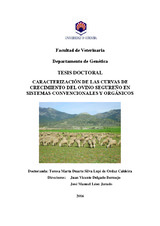Caracterización de las curvas de crecimiento del ovino segureño en sistemas convencionales y orgánicos
Autor
Duarte Silva Lupi de Ordaz Caldeira, Teresa Marta
Director/es
Delgado-Bermejo, J.V.León Jurado, J.M.
Editor
Universidad de Córdoba, UCOPressFecha
2016Materia
Raza ovina segureñaCurvas de crecimiento biológico
Asociación Nacional de Ciradores de Ovino Segureño (ANCOS)
METS:
Mostrar el registro METSPREMIS:
Mostrar el registro PREMISMetadatos
Mostrar el registro completo del ítemResumen
El programa de selección del ovino Segureño ha alcanzado un gran desarrollo en los
últimos años, situándose entre los más avanzados de España y de la UE. Por esta razón,
el equipo técnico responsable del mismo se ha planteado la búsqueda de nuevos criterios
de selección que repercutan positivamente en la competitividad de la raza. Entre estos
critérios destaca la utilización del significado biológico de la curva de crecimiento de
mejor ajuste, como criterio de selección para mejorar aspectos tales como la edad al
sacrificio, la precocidad, entre otros.
En la presente Tesis nos hemos responsabilizado de ese reto y para ello, utilizando los
datos entre los años de 2000 hasta 2015 de la base de datos histórica de la Asociación
Nacional de Criadores de Ovino Segureño (ANCOS), hemos desarrollado un estudio en
tres etapas que nos llevarán a ofrecer los mencionados nuevos criterios de selección al
programa genético. En una primera etapa se han analizado modelos no lineales para
describir las curvas de crecimiento biológico (del nacimiento hasta la edad adulta) y
comercial (del nacimiento hasta la edad de sacrificio) del ovino de raza Segureña. En una
segunda etapa se llevó a cabo un estudio para evaluar los efectos de los factores no
genéticos (sexo del cordero, época de nacimiento, rebaño, año de nacimiento y tipo de
parto) sobre el comportamiento en crecimiento de los animales, con vistas a optimizar los
modelos de análisis genéticos a utilizar sobre los parámetros de las curvas. Finalmente,
en una tercera etapa de definió la curva de mejor ajuste individual y sobre los parámetros
de la misma en cada animal se calcularon parámetros genéticos que nos ilustraron sobre
los niveles de variabilidad genética de los mismos en la población; sobre las relaciones
genéticas entre los parámetros y sobre todo, sobre sus habilidades como criterios de
selección potenciales. Estas tres etapas constituyeron los objetivos específicos de la
presente tesis, y cada uno de ellos dio lugar a un artículo específico que se publicó en
revistas de impacto. Los contenidos de los mismos se resumen a continuación:
En el primer trabajo (Characterization of commercial and biological growth curves in the
Segureña sheep breed. Animal 2015, 9, pp 1341-1348. doi:
10.1017/S1751731115000567. Cuartil 1, Factor de Impacto: 1.841) se analizaron los
modelos no lineales para describir las curvas de crecimiento biológicos y comerciales de
la oveja Segureña, una de las más importantes razas españolas. Evaluamos los modelos
de Brody, von Bertalanffy, Verhulst, Gompertz y logístico a partir de datos históricos de
la Asociación Nacional de Criadores de Ovino Segureña (ANCOS). Estos registros fueron... The sheep breeding program of Segureño breed has reached a great development in recent
years, ranking among the most advanced in Spain and EU. For this reason, its responsible
technical team has considered the search for new selection criteria which influence the
competitiveness of the breed, in which emphasizes the use of the biological meaning of
the best fit growth curve, as selection criteria to improve aspects such as age at slaughter,
precocity, among others.
In this thesis we have taken responsibility for this challenge and for this, using data
between the years 2000-2015 of the historical database of the National Association of
Segureño Sheep Breeders (ANCOS), we developed a study in three stages that lead us to
offer the aforementioned new criteria to the genetic program. In a first stage, it was
analysed nonlinear models describing biological (birth to adulthood) and commercial
(birth to slaughter age) growth curves of Segureña sheep breed. In a second stage a study
was conducted to evaluate the effects of non-genetic factors (sex, birth season, herd, birth
year and birth type) on the growth behaviour of the animals in order to optimize the
genetic analysis models to use of on the curves parameters. Finally, in a third stage it was
defined the individual best fit curve and with each animal parameters it was calculated
the genetic parameters that illustrated us on genetic variability levels of them in the
population, on genetic relationships between parameters and, above all, on their abilities
as potential selection criteria. These three stages constitute the specific objectives of this
thesis, and each led to a specific article published in journals of impact, and whose
contents are summarized below:
In the first paper (Characterization of commercial and biological growth curves in the
Segureña sheep breed. Animal 2015, 9, pp 1341-1348. doi:10.1017/S1751731115000567)
Non-linear models were analysed to describe both the biological and commercial growth
curves of the Segureña sheep, one of the most important Spanish breeds. We evaluated
Brody, von Bertalanffy, Verhulst, logistic and Gompertz models, using historical data
from the National Association of Segureña Sheep Breeders (ANCOS). These records
were collected between 2000 and 2013, from a total of 129 610 weight observations
ranging from birth to adulthood. The aim of this research was to establish the
mathematical behaviour of body development throughout this breed’s commercial life
(birth to slaughter) and biological life (birth to adulthood); comparison between both
slopes gives important information regarding the best time for slaughter, informs dietary...

